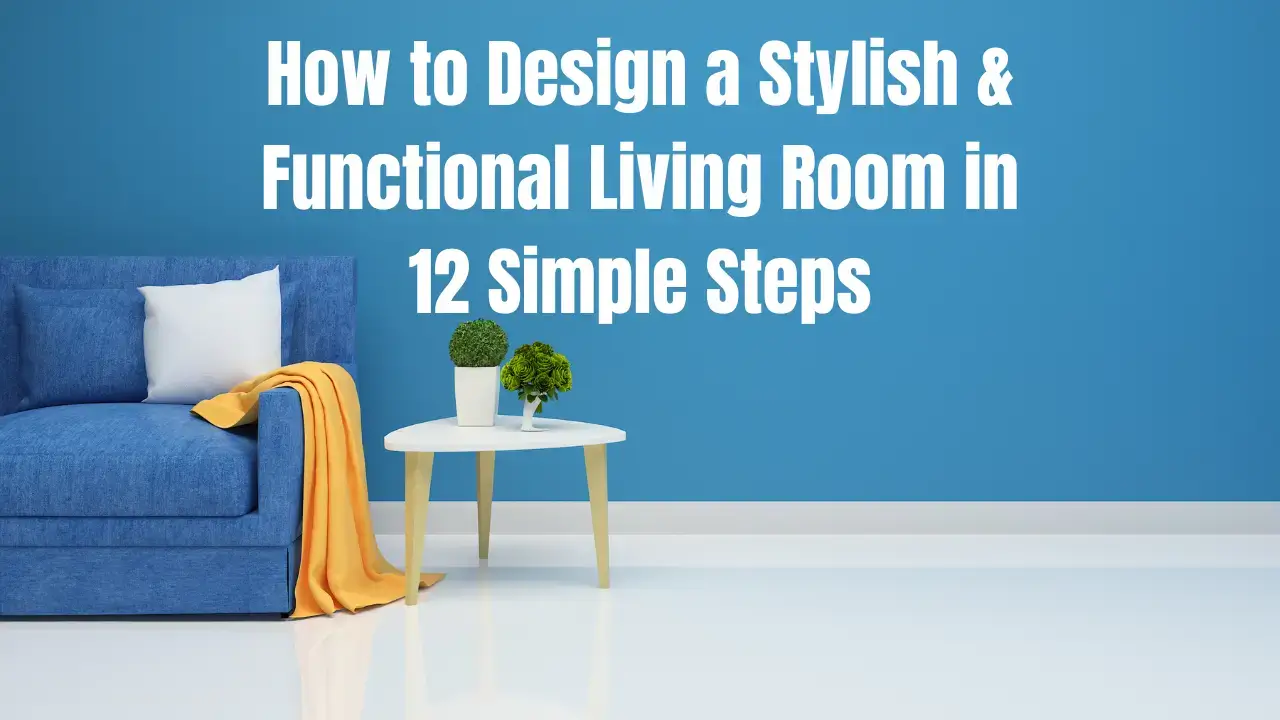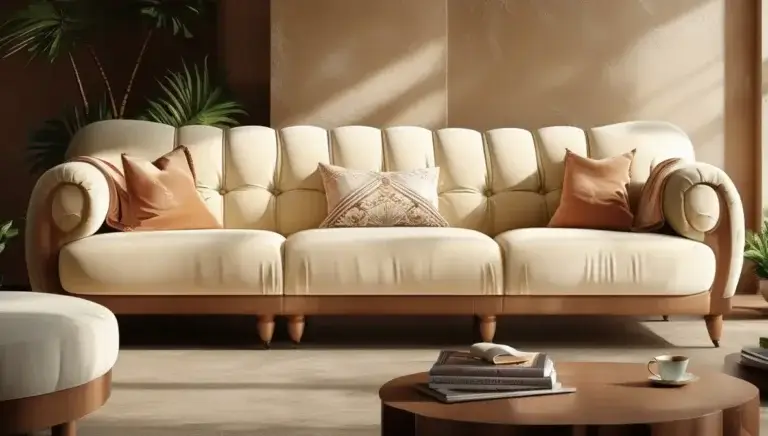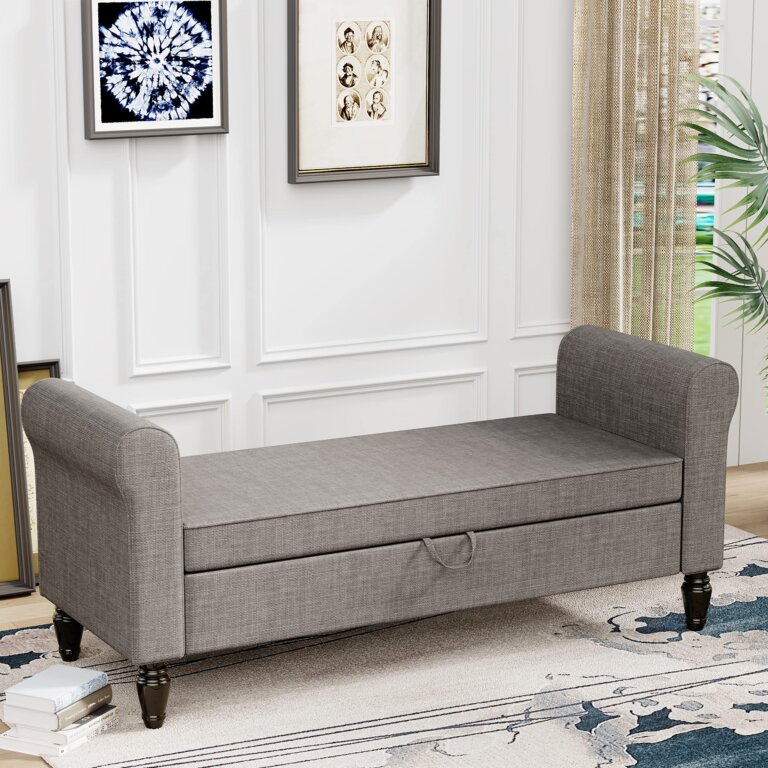Introduction
Your living room isn’t just a space—it’s the heartbeat of your home. It’s where you unwind after a long day, binge-watch your favorite shows, host friends for game night, and make memories with family. But designing a room that looks like a magazine spread while functioning for real life? That’s where things get tricky. Maybe your sofa feels awkwardly placed, the lighting is either too harsh or too dim, or clutter seems to multiply overnight. Sound familiar?
You’re not alone. Many struggle to balance style with practicality, often ending up with rooms that feel disjointed or underutilized. The good news? You don’t need a professional designer or a bottomless budget to fix it. In this guide, we’ll walk you through 12 simple, actionable steps to transform your living room into a space that’s as chic as it is functional. Whether you’re working with a cozy studio or an open-concept loft, these tips will help you maximize every square foot, choose timeless designs, and infuse your personality—without sacrificing comfort. Ready to create a living room that wows guests and works for you? Let’s get started!
Living Room Design Cost Calculator
Estimate your perfect living room transformation
Step 1: Plan Your Layout for Flow & Function
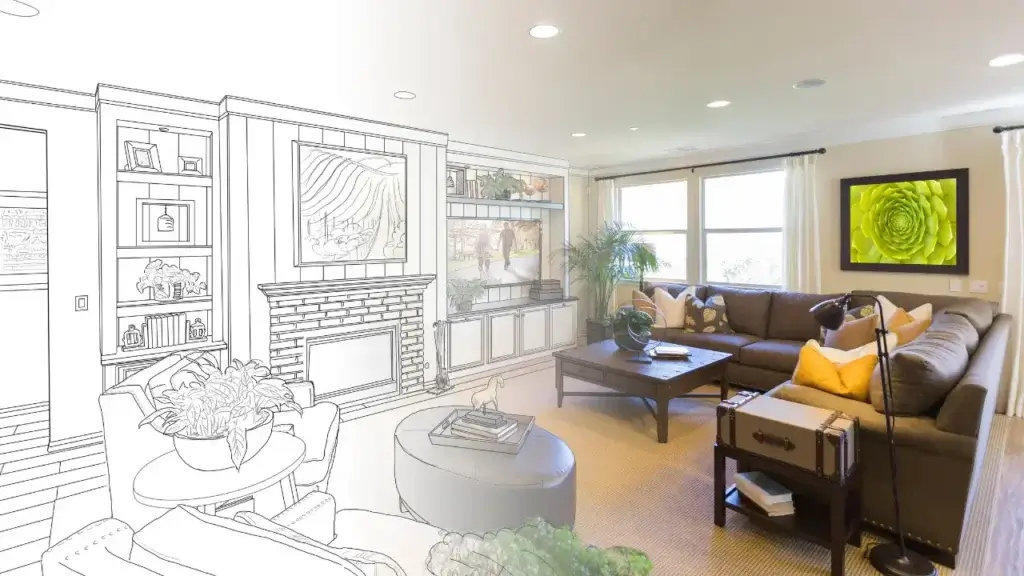
Think of your living room layout as the blueprint for everything else—it’s the foundation that determines how comfortable, functional, and inviting your space will feel. A poorly planned layout can leave you tripping over coffee tables or straining to hear conversations, while a thoughtful one ensures seamless movement and effortless interaction. Here’s how to nail it:
Start with Measurements
Grab a tape measure and jot down your room’s dimensions: length, width, ceiling height, and the locations of windows, doors, vents, and outlets. Don’t eyeball it—precision matters. Use free apps like MagicPlan or graph paper to sketch a digital or hand-drawn floor plan. This step helps you avoid buying furniture that’s too large (or too small) for your space.
Prioritize Traffic Flow
Every living room needs clear pathways. Aim for at least 3 feet of walking space between furniture pieces (the “3-foot rule”) to prevent a cluttered, maze-like feel. For example:
- Keep walkways between the sofa and TV stand unobstructed.
- Ensure doors and windows open fully without hitting furniture.
- Avoid placing chairs or tables in high-traffic zones (e.g., paths to the kitchen).
Experiment with Layout Styles
Choose a layout that aligns with your room’s shape and lifestyle:
- L-Shaped Arrangement: Perfect for square or corner-focused rooms. Place a sofa and loveseat (or chaise) at a right angle to create an intimate conversation zone.
- Symmetrical Layout: Ideal for traditionalists. Balance matching sofas or armchairs around a central coffee table for a formal, harmonious look.
- Open-Concept Zones: Use area rugs, lighting, or bookshelves to define “rooms” within a studio or loft (e.g., a reading nook vs. a TV area).
Pro Tips for Small Spaces
- Float furniture: Pull sofas and chairs away from walls to create the illusion of depth.
- Avoid oversized pieces: Opt for slim-arm sofas and leggy furniture to maintain airflow.
- Multitask with furniture: A narrow console behind the sofa can double as a workspace or bar cart.
Step 2: Define the Rooms Purpose
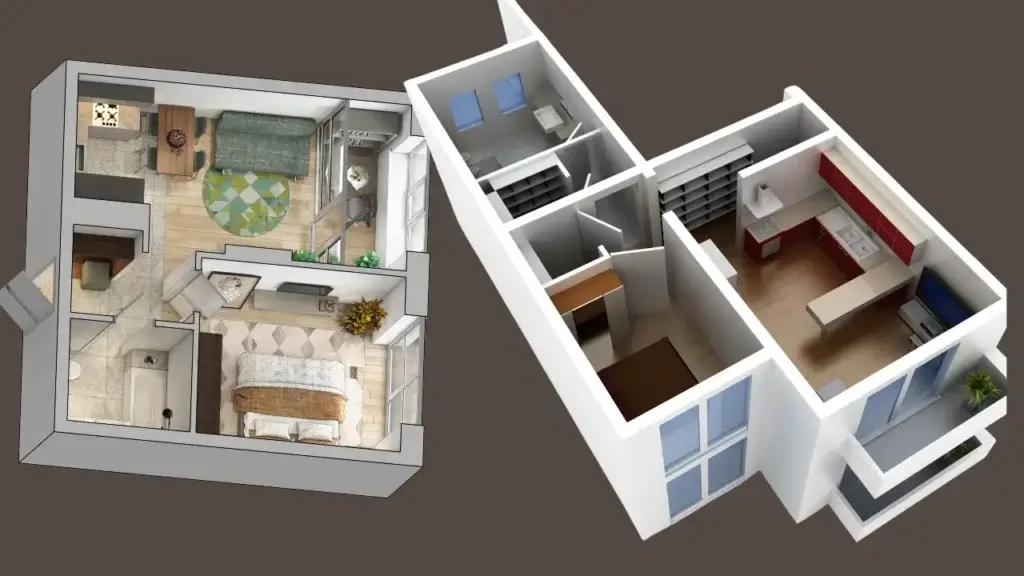
Your living room’s design should reflect how you actually live—not just what looks good on Pinterest. Before picking out decor or rearranging furniture, ask yourself: What do I want this space to do? Pinpointing its primary purpose ensures every choice supports your lifestyle, avoiding a beautiful-but-unusable room. Here’s how to clarify your vision:
Identify Key Activities
Start by listing how you (and your household) use the space most:
- Entertaining hub: Hosting game nights or dinner parties?
- Family relaxation zone: Movie marathons, homework, or playtime?
- Hybrid workspace: Need a spot for Zoom calls or creative projects?
- Quiet retreat: A place to read, meditate, or unwind solo?
Pro Tip: Survey everyone who uses the room! A teenager might crave a gaming corner, while a partner wants space for yoga.
Tailor Furniture & Layout
Once you’ve defined the main uses, customize accordingly:
- For Entertaining:
- Choose a large sectional or modular sofa to seat groups.
- Add flexible seating (ottomans, poufs) that can be moved as needed.
- Anchor the space with a spacious coffee table for snacks and board games.
- For Family Life:
- Prioritize durable, stain-resistant fabrics (performance microfiber, Crypton).
- Include kid-friendly storage: baskets for toys, low shelves for books.
- Opt for rounded furniture (no sharp edges!) and soft rugs for play areas.
- For Work or Hobbies:
- Carve out a dedicated zone with a compact desk and task lighting.
- Use a room divider, bookshelf, or area rug to separate work from leisure.
- Hide office supplies in stylish storage (e.g., a vintage trunk or woven bins).
Multipurpose Magic
If your living room needs to juggle multiple roles, use zoning strategies:
- Furniture Arrangement: Position the sofa to face both the TV (for relaxation) and a desk nook (for productivity).
- Lighting Layers: Bright task lighting for work areas, warm ambient lights for lounging.
- Dual-Function Pieces: A storage ottoman can hold blankets and serve as a coffee table.
Avoid Common Mistakes
- Overcrowding: Don’t cram in a dining table, home office, and play area if your room is tiny. Prioritize 2-3 key uses.
- Ignoring Traffic Flow: Ensure pathways between zones remain clear—no tripping over yoga mats!
Step 3: Choose a Cohesive Color Palette

A well-curated color palette is the secret sauce that ties your living room together. It sets the mood, enhances the perception of space, and ensures every element—from walls to throw pillows—feels intentional. But with endless hues to choose from, where do you start? Follow this foolproof framework to create a harmonious scheme that reflects your style and amplifies functionality.
Why Color Matters
- Mood Magic: Warm tones (terracotta, mustard) energize; cool tones (sage, slate) soothe.
- Space Perception: Light colors open up small rooms; dark shades add cozy intimacy.
- Visual Flow: A cohesive palette guides the eye and unifies mismatched furniture.
The 60-30-10 Rule: Your Color Blueprint
This timeless design principle simplifies balancing hues:
- 60% Dominant Color: Sets the room’s foundation.
- Where: Walls, large furniture (sofas, rugs).
- Neutral Living Room Ideas: Soft whites, warm beiges, or greige for timeless flexibility.
- 30% Secondary Color: Adds depth and contrast.
- Where: Curtains, accent chairs, statement walls.
- Pro Tip: Muted greens, blues, or blush pinks work beautifully with neutrals.
- 10% Accent Color: Pops of personality.
- Where: Throw pillows, art, decor, or a bold armchair.
- Go Bold: Try emerald, burnt orange, or navy for drama.
Example Palette:
- Dominant: Warm white (Benjamin Moore Simply White).
- Secondary: Earthy sage green (Farrow & Ball Pigeon).
- Accent: Terracotta and brass accents.
Practical Tips for Choosing Colors
- Test in Your Space: Paint large swatches on walls and observe at different times of day.
- Consider Lighting: North-facing rooms? Warm tones counter cool light. South-facing? Cool hues balance brightness.
- Work with Existing Elements: Match your palette to fixed features (flooring, fireplace stone) or a favorite rug/artwork.
- Small Room Hack: Use a monochromatic scheme (variations of one color) to amplify space.
Avoid These Common Mistakes
- Too Many Colors: Stick to 3–4 hues max to prevent visual chaos.
- Ignoring Undertones: Clashing undertones (e.g., warm vs. cool grays) can make colors feel “off.”
- Forgetting Function: A home office nook might need calming tones; a play area can handle vibrant accents.
Pro Tips for Timeless Appeal
- Layer Textures: Add depth with a cream linen sofa, nubby wool rug, and metallic gold lamps—all within a neutral base.
- Embrace Color Psychology: Blue promotes relaxation (perfect for reading corners); yellow sparks joy (ideal for social hubs).
- Trend-Proof Your Palette: Keep bold colors to easily swappable items (pillows, art) and invest in neutral big-ticket pieces.
Step 4: Invest in Functional, Stylish Furniture
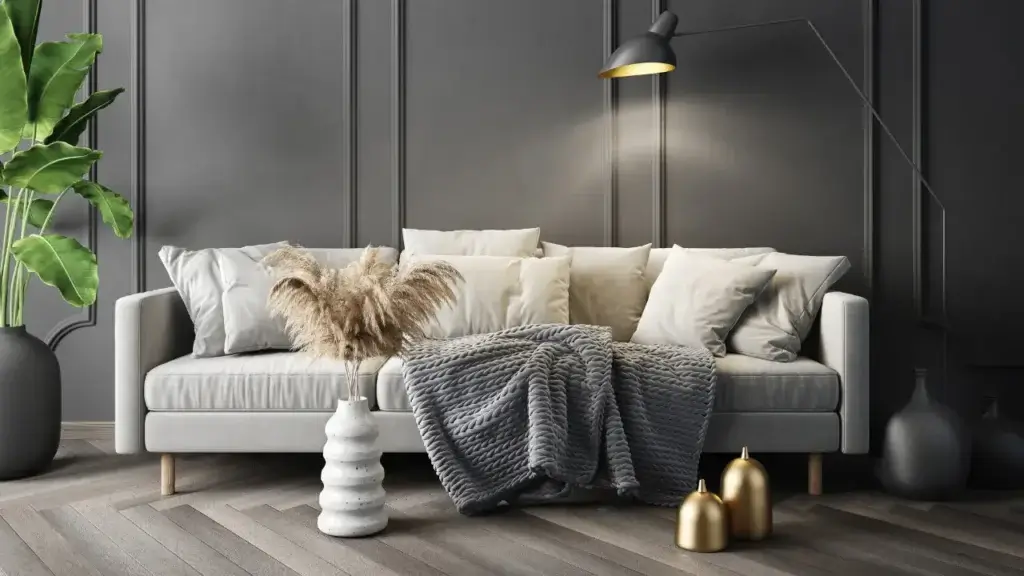
Furniture is the backbone of your living room—it dictates comfort, defines style, and supports daily life. But striking the balance between form and function can be tricky. The key? Choose pieces that work as hard as you do while elevating your design vision. Here’s how to curate a furniture lineup that’s both practical and polished.
1. Prioritize Comfort & Durability
Your sofa isn’t just for show—it’s where you’ll binge Netflix, host friends, and nap on Sundays. Invest in quality that lasts:
- Performance Fabrics: Stain-resistant Crypton, Sunbrella, or microfiber for homes with kids, pets, or messy snackers.
- Solid Construction: Look for hardwood frames, reinforced corners, and high-density foam cushions. Test seats in-store—good sofas shouldn’t sag or squeak!
- Ergonomic Support: Deep seats (22–24 inches) for lounging, firmer backs for posture.
Pro Tip: Neutral-colored upholstery (gray, beige) offers timeless flexibility. Add personality with bold throw pillows or slipcovers.
2. Embrace Multifunctional Magic
Maximize small spaces or hybrid rooms with pieces that multitask:
- Storage Ottomans: Stash blankets, serve as extra seating, or act as a coffee table.
- Sleeper Sofas: Perfect for studio apartments or guest-ready spaces (look for memory foam mattresses!).
- Nesting Tables: Tuck away when not in use, or spread out for game night.
- Modular Sectionals: Reconfigure layouts to suit gatherings or solo relaxation.
Example: A console table with built-in drawers hides remote controls while displaying decor.
3. Choose Style That Complements Your Vision
Furniture should align with your room’s aesthetic—without sacrificing practicality:
- Modern Minimalist: Clean-lined sofas with tapered legs and hidden storage.
- Rustic Farmhouse: Reclaimed wood coffee tables or leather armchairs with patina.
- Eclectic Vibes: Mix vintage finds (think mid-century sideboards) with contemporary silhouettes.
Avoid: Overcrowding—leave breathing room between pieces to maintain flow.
4. Smart Shopping on a Budget
Quality doesn’t have to break the bank:
- Secondhand Gems: Scout Facebook Marketplace or thrift stores for solid wood dressers or vintage armchairs.
- Sales & Floor Models: Hit holiday sales or ask about discounted floor samples.
- Affordable Brands: IKEA, Article, and Wayfair offer stylish, durable options under $1,000.
Pro Tip: Splurge on your sofa (it’s the hero!), then save on accent chairs and side tables.
5. Sustainable & Ethical Choices
Furnish mindfully:
- Eco-Friendly Materials: Bamboo, FSC-certified wood, or recycled metal.
- Second Life: Upcycle old furniture with paint or new hardware.
- Brands with Purpose: Patagonia’s reclaimed wool rugs, Joybird’s carbon-neutral shipping.
Common Mistakes to Avoid
- Ignoring Scale: A massive sectional can overwhelm a petite room—measure twice!
- Trend Overload: Skip fast-fashion furniture. Timeless designs outlast fleeting fads.
- Forgetting Lifestyle: A white velvet sofa isn’t ideal for a house full of toddlers (no matter how pretty it looks).
Step 5: Layer Lighting for Ambiance & Practicality
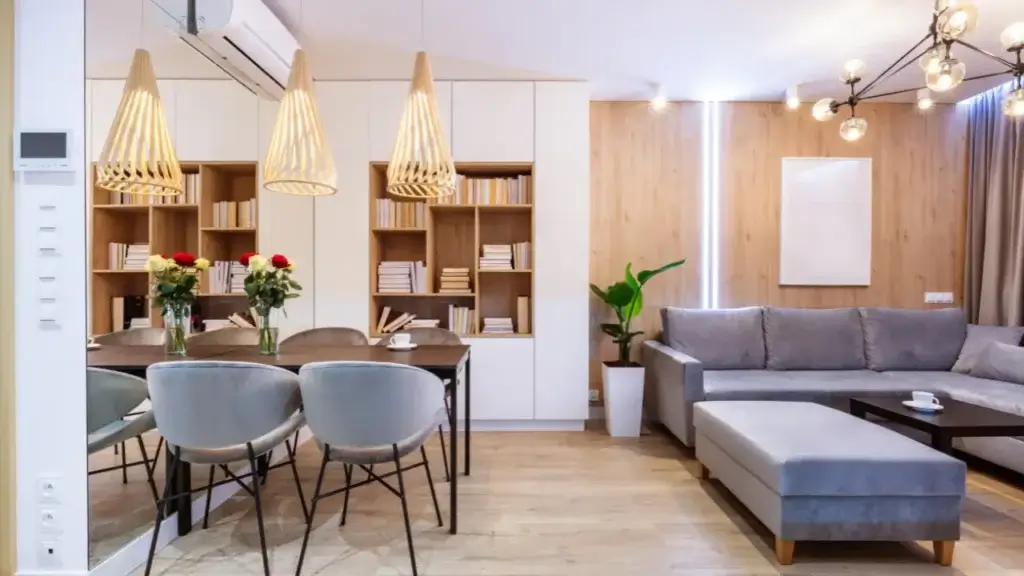
Lighting is the unsung hero of living room design—it can elevate mood, highlight decor, and make everyday tasks effortless. But relying solely on a glaring overhead fixture? That’s a recipe for a sterile, uninspiring space. The secret to a warm, functional room? Layered lighting. Here’s how to mix ambient, task, and accent lighting like a pro.
1. Master the Three Types of Lighting
Think of lighting layers as your design toolkit:
- Ambient Lighting:
- Purpose: The base layer that fills the room with general illumination.
- Examples: Recessed ceiling lights, chandeliers, or track lighting.
- Pro Tip: Install dimmer switches to adjust brightness for movie nights vs. midday chores.
- Task Lighting:
- Purpose: Focused light for specific activities (reading, working, crafting).
- Examples: Adjustable floor lamps, desk lamps, or swing-arm wall sconces.
- Placement: Position near seating areas, desks, or side tables.
- Accent Lighting:
- Purpose: Adds drama and highlights architectural features or decor.
- Examples: LED strip lights under shelves, picture lights above art, or tabletop lamps with directional shades.
- Pro Tip: Use accent lighting to draw attention to a gallery wall or plant collection.
2. Create Balance with Fixtures
Mix styles and heights for visual interest:
- Statement Overhead: A sculptural pendant or modern chandelier anchors the room.
- Floor Lamps with Personality: Try a tripod base or a curved arc lamp for mid-century flair.
- Table Lamps as Decor: Choose bases in materials like ceramic, brass, or marble to complement your palette.
Example Layout:
- Ambient: A dimmable ceiling fixture.
- Task: A pair of swing-arm sconces flanking the sofa.
- Accent: A sleek LED strip behind the media console for subtle glow.
3. Light Temperature Matters
- Warm White (2700K–3000K): Cozy, inviting glow for living rooms.
- Cool White (3500K–4100K): Crisp, energizing light best for task areas.
- Smart Bulbs: Adjust color temperature throughout the day (e.g., warm at night, cool in the morning).
Avoid: Mixing clashing temperatures—stick to one dominant tone for harmony.
4. Small Space Hacks
- Wall Sconces: Free up floor space while adding style.
- Plug-In Pendants: No hardwiring needed—hang over a reading nook or side table.
- Mirrors: Place lamps near mirrors to amplify light.
Common Mistakes to Avoid
- Overhead-Only Lighting: Creates harsh shadows and a clinical vibe.
- Ignoring Scale: A tiny lamp on a large side table gets lost—aim for proportional sizing.
- Forgetting Corners: Dark corners make rooms feel smaller. Use a tall floor lamp or uplight to brighten them.
Pro Tips for Instant Impact
- Layer with Dimmer Switches: Control ambiance for every occasion.
- Use Lampshades Strategically: White linen diffuses light softly; black shades create moody pools of light.
- Highlight Textures: Angle a directional lamp toward a textured rug or woven basket to cast subtle shadows.
Step 6: Add Texture with Textiles
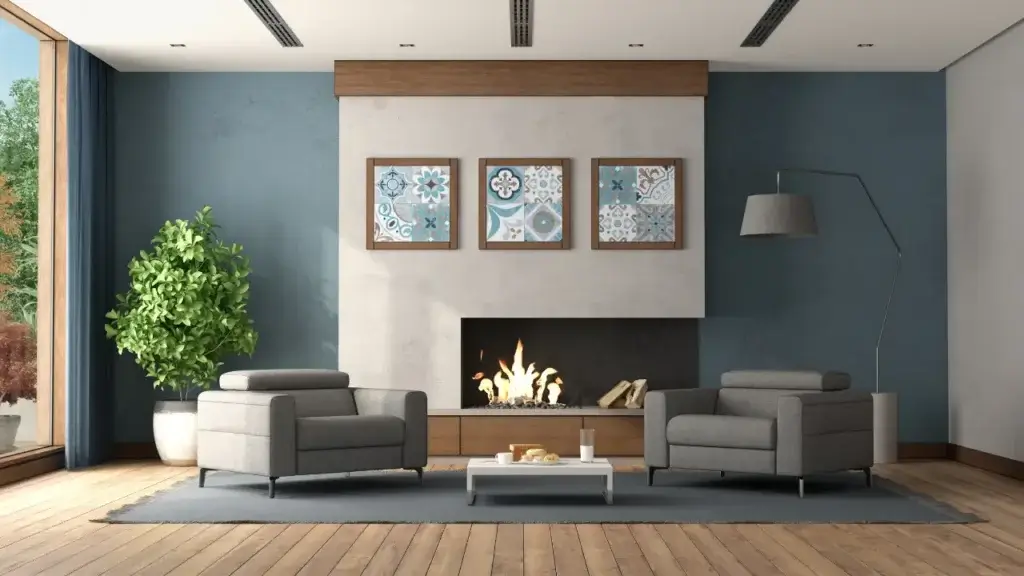
Texture is the secret ingredient that turns a flat, one-dimensional room into a space that feels rich, inviting, and lived-in. Think of textiles as the “soul” of your living room—they soften hard surfaces, add warmth, and create visual interest that keeps the eye moving. Here’s how to layer fabrics like a pro, balancing coziness with sophistication.
Why Texture Matters
- Depth & Dimension: Smooth leather, nubby wool, and silky linen interact to create contrast.
- Comfort Factor: Soft throws and plush rugs make spaces feel instantly welcoming.
- Acoustic Benefits: Textiles absorb sound, reducing echoes in open-concept rooms.
Start with a Textural Foundation
- Rugs: Anchor the room with a rug that sets the tone.
- Material Choices:
- Jute or Sisal: Natural, durable, and earthy (ideal for rustic or coastal styles).
- Wool: Soft underfoot, stain-resistant, and warm (perfect for traditional or modern spaces).
- Low-Pile Synthetic: Easy to clean, great for high-traffic homes.
- Layering Hack: Place a smaller patterned rug over a larger neutral one for bohemian flair.
- Material Choices:
- Curtains: Frame windows with fabric that complements your vibe.
- Sheer Linen: Airy and light-filtering for a relaxed look.
- Velvet or Heavy Cotton: Adds drama and insulation in colder climates.
Layer in Softness & Personality
- Throw Pillows: Mix materials and scales for a collected feel.
- Combinations:
- Pair linen pillow covers with velvet or faux fur accents.
- Add geometric-stitched pillows for subtle pattern.
- Rule of Three: Odd numbers (3–5 pillows per sofa) feel more dynamic.
- Combinations:
- Throws & Blankets: Drape them over sofas or chairs for instant coziness.
- Chunky Knits: Ideal for winter months.
- Lightweight Cotton or Bamboo: Perfect for summer.
Seasonal Swaps for Year-Round Versatility
- Summer: Swap wool throws for lightweight, breathable cotton or linen. Use sheer curtains to maximize natural light.
- Winter: Introduce faux fur pillows, cable-knit blankets, and heavier drapes in rich tones like burgundy or charcoal.
Pro Tips for Cohesive Layering
- Stick to Your Palette: Pull colors from your Step 3 scheme to unify diverse textures.
- Vary Scales: Combine large-weave baskets with finely textured rugs.
- Balance Shiny & Matte: Pair a glossy velvet pillow with a rough-hewn jute rug for contrast.
Common Mistakes to Avoid
- Overloading Patterns: If using patterned textiles (stripes, florals), keep them in the same color family.
- Ignoring Function: Skip delicate silks or light-colored fabrics in homes with pets or kids.
- Mismatched Proportions: A tiny 4’x6’ rug under a large sectional will feel lost—size up!
Step 7: Incorporate Smart Storage Solutions
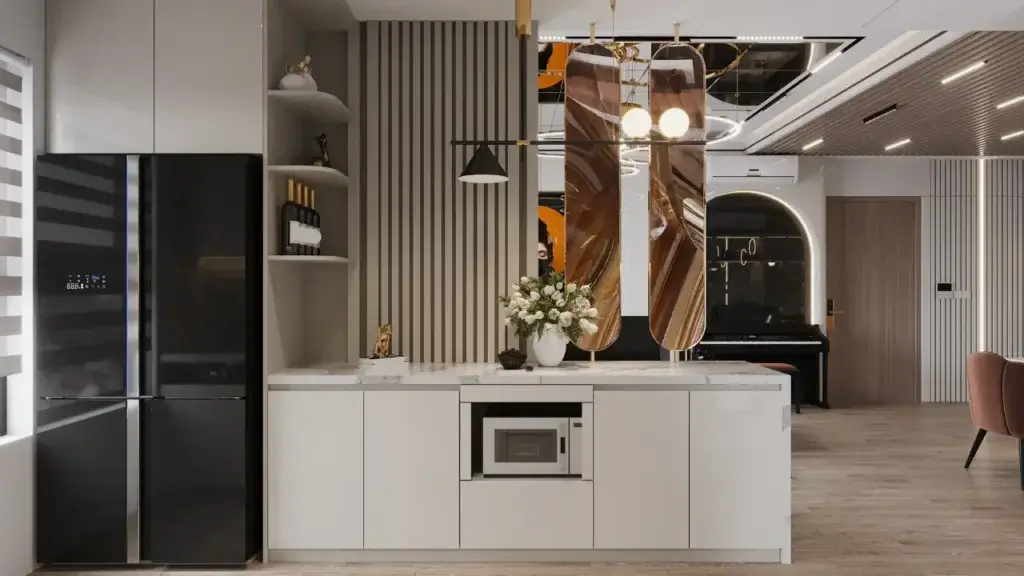
Clutter is the enemy of both style and function—yet life has a way of filling every surface with stuff. The key to a polished, functional living room? Clever storage that works invisibly (or looks so good, it doubles as decor). From hidden compartments to display-worthy solutions, here’s how to tame the chaos without sacrificing aesthetics.
1. Built-In Storage: Maximize Every Inch
Built-ins are the ultimate storage luxury, blending seamlessly with your room’s architecture:
- Custom Shelving: Floor-to-ceiling units around a fireplace or TV for books, decor, and media.
- Window Seats with Cabinets: Perfect for storing blankets, games, or seasonal decor.
- Under-Stair Nooks: Transform dead space into drawers or open cubbies.
Pro Tip: Paint built-ins the same color as your walls for a streamlined look.
2. Multifunctional Furniture: Double Duty Design
Choose pieces that hide clutter while serving another purpose:
- Storage Ottomans: Stash remotes, magazines, or toys inside.
- Coffee Tables with Drawers or Lift-Tops: Ideal for hiding charging cords or board games.
- Benches with Hidden Compartments: Use in entryways or under windows.
Example: A console table with baskets underneath keeps dog leashes or kids’ crafts out of sight.
3. Vertical Space: Look Up!
Walls and unused vertical areas are prime real estate:
- Floating Shelves: Display plants, art, or books while keeping surfaces clear.
- Over-the-Door Organizers: Store throw blankets, scarves, or tech accessories.
- Tall Bookcases: Opt for sleek, narrow units in small spaces.
Small Space Hack: Use a ladder shelf to add storage without overwhelming the room.
4. Hidden & Discreet Solutions
Camouflage storage to maintain a minimalist vibe:
- Baskets & Bins: Woven seagrass or fabric bins corral toys, pillows, or pet supplies.
- Decorative Boxes: Use stylish lacquered boxes on shelves for random clutter (e.g., batteries, keys).
- Behind-the-Sofa Console: A slim table with drawers hides items while anchoring the sofa.
5. Decluttering Rules to Live By
- The One-In, One-Out Rule: For every new item, donate or discard an old one.
- Zone It: Assign storage spots for categories (e.g., a basket for remote controls, a tray for candles).
- Edit Ruthlessly: If you haven’t used it in a year, let it go (yes, even that decorative vase).
Pro Tips for Style-Meets-Storage
- Open Shelving as Decor: Style shelves with curated items (books, plants, ceramics) and reserve 30% of space for hidden baskets.
- Match Materials: Choose storage bins in colors/textures that complement your furniture (e.g., leather bins with a cognac sofa).
- Label Secretly: Use chalkboard tags or discreet stickers inside baskets to stay organized.
Common Mistakes to Avoid
- Overcrowding Shelves: Leave breathing room—aim for 20% empty space.
- Ignoring Aesthetics: A plastic bin in a chic room sticks out like a sore thumb—opt for stylish alternatives.
- Forgetting Accessibility: Store frequently used items (throws, remotes) in easy-to-reach spots.
Step 8: Create a Focal Point
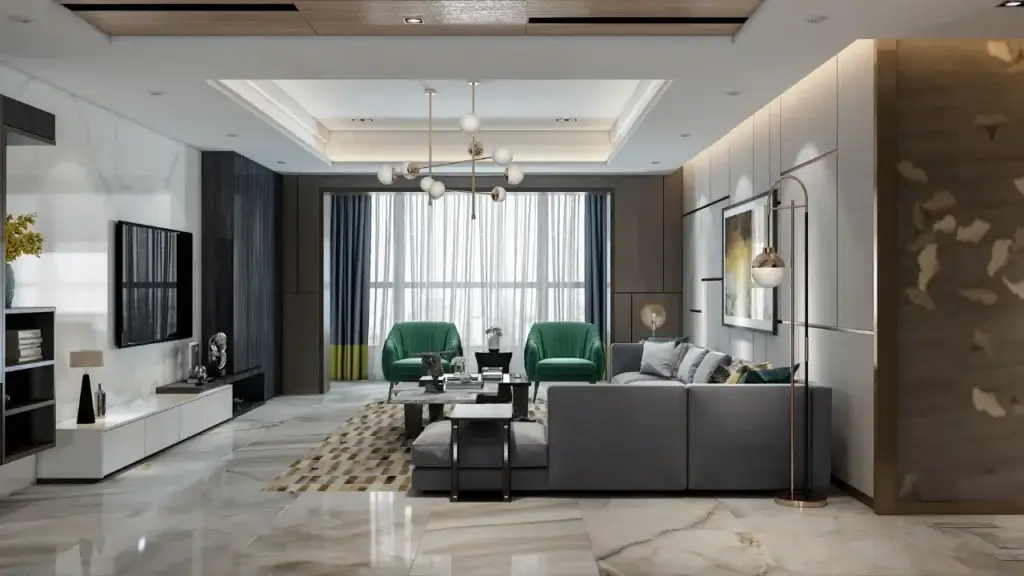
A focal point anchors your living room, giving it purpose and visual harmony. It’s the star of the space—a feature that draws the eye and sets the tone for the entire design. Whether your room has an architectural gem or needs a crafted centerpiece, here’s how to create a focal point that wows.
Why a Focal Point Matters
- Visual Hierarchy: Directs attention and prevents the room from feeling chaotic.
- Functional Flow: Guides furniture arrangement and social interaction.
- Personality Showcase: Reflects your style, whether bold, minimalist, or cozy.
Identify or Create Your Focal Point
- Natural Features:
- Fireplace: Highlight with a statement mantel, mirror, or artwork above.
- Large Windows: Frame with luxurious drapes or position seating to admire the view.
- Architectural Details: Expose beams, brick walls, or built-in shelving.
- Crafted Features:
- Statement Artwork: Go big! A oversized painting or gallery wall commands attention.
- Media Wall: Elevate your TV with a sleek console, floating shelves, or textured backdrop.
- Accent Wall: Use bold paint, wallpaper, or wood paneling to create drama.
- Lighting: A sculptural chandelier or modern floor lamp can steal the show.
Enhance Your Focal Point
- Lighting: Use spotlights, sconces, or LED strips to illuminate artwork or architectural details.
- Symmetry: Flank a fireplace with matching chairs or bookshelves for balance.
- Color Contrast: Paint the wall behind your focal point a deeper hue (e.g., navy behind a white sofa).
Arrange Furniture Around It
- Face the Focal Point: Position sofas and chairs toward the fireplace, TV, or artwork.
- Distance Matters: Ensure seating is 8–12 feet from a TV for comfortable viewing.
- Create Zones: In open-concept spaces, use area rugs to tie seating to the focal point.
Small Space Solutions
- Mirror Magic: Hang a large mirror to mimic a window and amplify light.
- Vertical Focus: Use tall bookshelves or hanging plants to draw the eye upward.
- Multifunctional Pieces: A bold, colorful sofa can double as the focal point.
Avoid Common Mistakes
- Too Many Focal Points: Competing features = visual chaos. Stick to one star.
- Ignoring Scale: A tiny painting on a large wall gets lost—size matters!
- Overcrowding: Leave breathing room around the focal point to let it shine.
Pro Tips for Impact
- Layer Textures: Pair a stone fireplace with a plush rug and metallic accents.
- Dynamic Displays: Rotate seasonal decor (e.g., holiday garlands on a mantel).
- Functional Focal Points: Choose a media console with hidden storage to blend style and utility.
Step 9: Personalize with Decor & Art
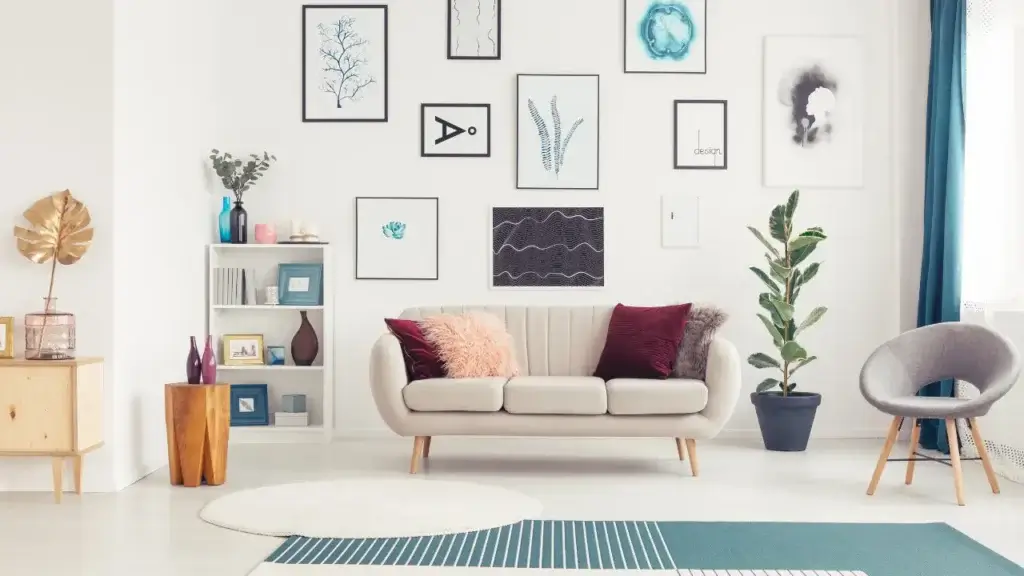
Decor and art transform a living room from a generic showroom into a space that tells your story. This step is where you inject personality, spark joy, and create conversation starters. Forget trends—focus on pieces that resonate with you, whether it’s a vintage travel poster, your child’s framed doodle, or a quirky thrifted lamp. Here’s how to curate a room that feels authentically yours.
1. Choose Meaningful Decor
Skip mass-produced knickknacks and opt for items that reflect your passions, memories, or hobbies:
- Travel Souvenirs: Display a collection of ceramic bowls from Morocco or framed postcards from Paris.
- Family Heirlooms: A vintage clock from Grandma or a quilt passed down through generations.
- DIY Projects: Hand-painted vases, macramé wall hangings, or framed poetry you’ve written.
Pro Tip: Group smaller items on a tray or shelf to avoid a cluttered look.
2. Master the Gallery Wall
A gallery wall is the ultimate way to showcase art, photos, and eclectic finds. Follow these rules for a polished display:
- Plan the Layout: Arrange frames on the floor first or use paper templates taped to the wall.
- Mix & Match: Combine framed art, mirrors, woven baskets, and 3D objects (like sconces or plates).
- Balance Spacing: Keep 2–3 inches between frames for cohesion.
- Anchor with a Centerpiece: Place the largest piece at eye level (57–60 inches from the floor).
Style Idea: Blend black-and-white family photos with abstract prints and a round brass mirror.
3. Scale Art to Your Space
Size matters! Avoid art that’s too small or overwhelming:
- Above Furniture: Art should span 50–75% of the width of your sofa or console.
- Large Walls: Go big with a oversized canvas or a triptych (three-panel piece).
- Small Walls: Cluster tiny frames in a grid or vertical line.
Budget Hack: Use digital art prints from Etsy—frame them in thrifted frames for a custom look.
4. Mix High & Low, Old & New
- Thrifted Treasures: Hunt for unique finds like retro lamps, mid-century ceramics, or antique books.
- Affordable Art Sources: Society6, Minted, local art fairs, or even Instagram artists.
- Splurge Pieces: Invest in one statement item (e.g., a bold sculpture or original painting).
5. Rotate & Refresh
Keep your decor dynamic:
- Seasonal Swaps: Switch out summer seashells for autumnal pumpkins or holiday greenery.
- Artistic Experiments: Repurpose scarves as wall hangings or frame fabric swatches.
- Sentimental Updates: Add new family photos or travel mementos yearly.
Common Mistakes to Avoid
- Overcrowding: Leave negative space—not every surface needs decor.
- Ignoring Lighting: Use picture lights or spotlights to highlight art.
- Playing It Safe: Don’t shy away from bold colors or unconventional pieces if they speak to you.
Pro Tips for Maximum Impact
- Create Vignettes: Style a side table with a stack of books, a small plant, and a ceramic vase.
- Tell a Story: Pair a map of your hometown with a vintage suitcase for a travel-themed corner.
- Unexpected Displays: Lean large art against walls or hang hats/quilts as wall decor.
Step 10: Optimize Small Spaces
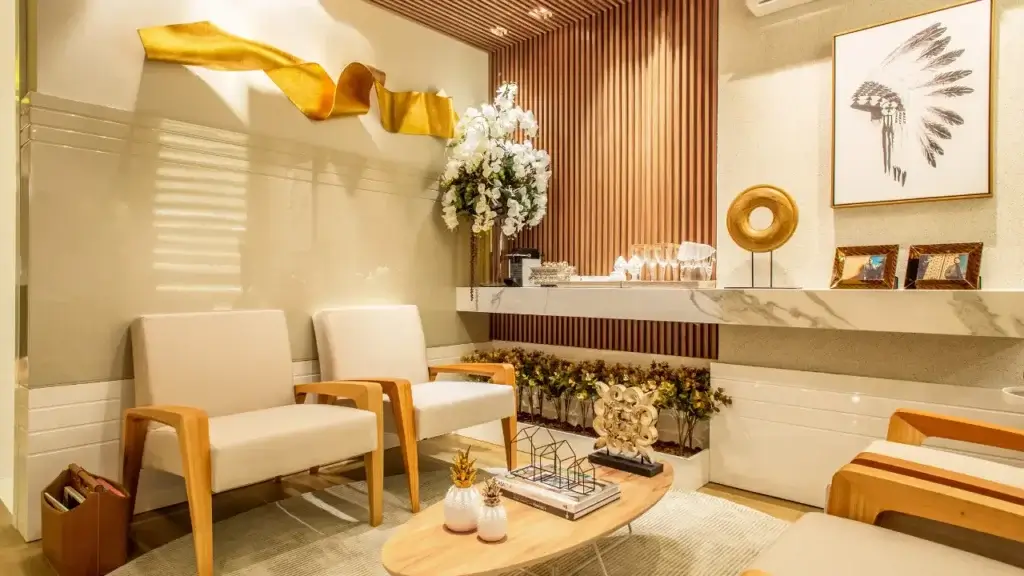
A small living room doesn’t mean sacrificing style or function—it just requires smart design choices. With strategic planning, even the coziest spaces can feel airy, organized, and inviting. Here’s how to maximize every square inch while keeping your sanity (and style) intact.
1. Embrace Light & Bright Colors
Light hues visually expand a room, while dark tones absorb light and shrink spaces:
- Walls & Ceilings: Stick to soft whites, pale grays, or warm beiges.
- Furniture: Opt for light-colored upholstery (cream, blush, or light gray).
- Accents: Add pops of color with pillows, art, or a rug—keep them muted (sage, dusty rose) to avoid overwhelming the space.
Pro Tip: Paint trim and ceilings the same color as walls to blur boundaries and heighten the room.
2. Mirror, Mirror on the Wall
Mirrors amplify light and create the illusion of depth:
- Placement: Hang a large mirror opposite a window to reflect natural light.
- Styling: Lean a floor-length mirror against a wall or use a cluster of small mirrored decor.
- Functional Decor: Choose mirrored furniture (consoles, side tables) to add shine without bulk.
3. Think Vertical
Utilize wall space to free up floor area:
- Floating Shelves: Display books, plants, or decor above eye level.
- Tall Bookcases: Draw the eye upward with narrow, floor-to-ceiling units.
- Wall-Mounted TV: Save floor space with a slim mount and floating media console.
Small Space Hack: Use the area above doorways for shallow shelves to store rarely used items.
4. Choose Multipurpose & Scalable Furniture
Every piece should earn its keep:
- Storage Ottomans: Seating + hidden storage for blankets or toys.
- Nesting Tables: Compact when not in use, expandable for guests.
- Sofa Beds: Perfect for studio apartments (look for sleek, low-profile designs).
- Armless Chairs: Save space compared to bulky wingbacks.
Avoid: Oversized sectionals—opt for a loveseat or apartment-sized sofa instead.
5. Keep It Airy with Leggy Furniture
Furniture with exposed legs creates visual breathing room:
- Sofas & Chairs: Mid-century modern styles with tapered legs.
- Glass or Acrylic: Coffee tables or side tables disappear visually.
- Raised Shelving: Use slim-legged consoles to maintain flow.
6. Streamline Clutter with Smart Storage
Clutter is the enemy of small spaces:
- Built-Ins: Custom shelves around a fireplace or TV.
- Baskets & Bins: Corral remotes, magazines, or pet toys in woven or fabric containers.
- Hidden Compartments: Choose beds or benches with under-seat storage.
Common Mistakes to Avoid
- Blocking Natural Light: Use sheer curtains instead of heavy drapes.
- Pushing All Furniture Against Walls: Float pieces to create zones and improve flow.
- Overcrowding: Less is more—curate decor and furniture ruthlessly.
Pro Tips for Instant Impact
- Foldable Everything: Foldable desks, stools, or Murphy beds maximize flexibility.
- Rug Trick: Use a large rug (8’x10’+) to anchor the space—small rugs make rooms feel tinier.
- Vertical Stripes: Incorporate striped curtains or wallpaper to elongate walls.
Step 11: Bring in Greenery
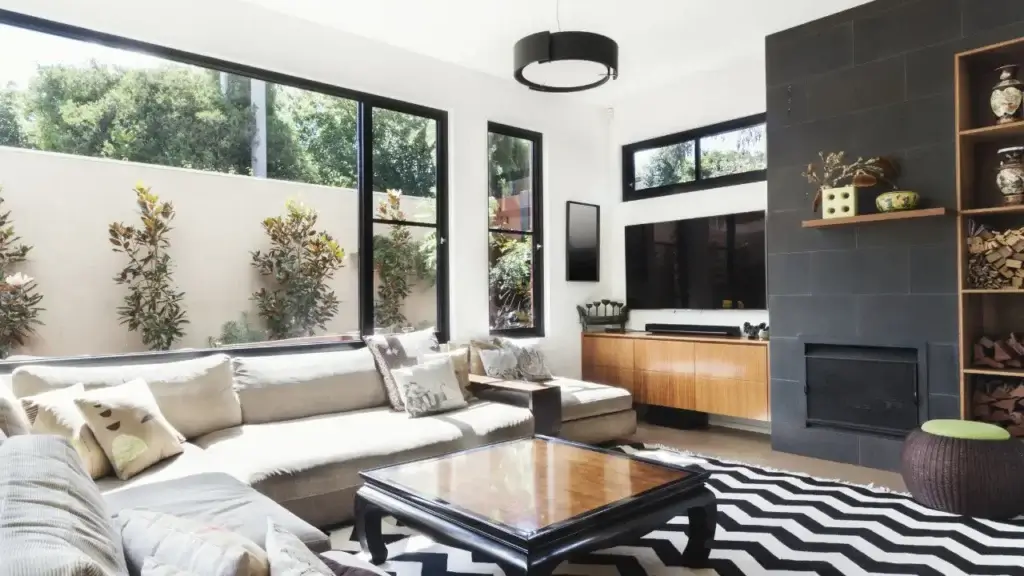
Plants are the ultimate design hack—they breathe life into your living room, purify the air, and add a touch of nature’s serenity. Whether you’re a seasoned plant parent or a newbie with a faux fiddle leaf fig, here’s how to integrate greenery for a fresh, vibrant space that thrives.
1. Benefits of Greenery in Design
- Aesthetic Boost: Plants soften hard edges, add texture, and infuse color.
- Air Quality: NASA-approved air purifiers like snake plants and peace lilies filter toxins.
- Mood Enhancer: Studies show greenery reduces stress and boosts creativity.
2. Choose the Right Plants for Your Lifestyle
- Low-Maintenance Picks:
- Snake Plant: Thrives in low light; water sparingly.
- Pothos: Trails beautifully; tolerates neglect.
- ZZ Plant: Survives in dim corners and droughts.
- Pet-Friendly Options: Spider plants, Boston ferns, and calatheas.
- Light Considerations:
- Bright Light: Bird of paradise, succulents.
- Low Light: Cast iron plant, philodendron.
3. Style Plants Like a Pro
- Vary Heights & Sizes: Pair a tall fiddle leaf fig with mid-height monstera and trailing ivy.
- Statement Planters: Opt for ceramic pots, woven baskets, or sleek concrete designs.
- Groupings: Cluster 3–5 plants in odd numbers for visual harmony.
- Vertical Gardens: Use wall-mounted planters or floating shelves for small spaces.
4. Strategic Placement
- Focal Points: Frame a window with a lush fern or place a large plant beside a sofa.
- Empty Corners: Fill awkward gaps with a towering palm or fiddle leaf fig.
- Tables & Shelves: Add petite succulents, air plants, or a bonsai to coffee tables.
5. Keep Plants Thriving
- Water Wisely: Use a moisture meter or the “finger test” to avoid overwatering.
- Dust Leaves: Wipe with a damp cloth to keep photosynthesizing efficiently.
- Rotate: Turn pots weekly for even light exposure.
- Pest Control: Spray neem oil for aphids; isolate infected plants.
Common Mistakes to Avoid
- Ignoring Light Needs: Don’t place a sun-loving succulent in a dark hallway.
- Overcrowding: Give plants space to grow—no jungle vibes unless intentional!
- Forgetting Drainage: Use pots with holes to prevent root rot.
Pro Tips for Instant Impact
- Faux Plants: Realistic faux options (like Nearly Natural) for low-light zones or busy schedules.
- Terrariums: Create a mini ecosystem with moss and succulents in glass containers.
- Seasonal Swaps: Add blooming orchids in spring, red poinsettias in winter.
Step 12: Integrate Tech Thoughtfully
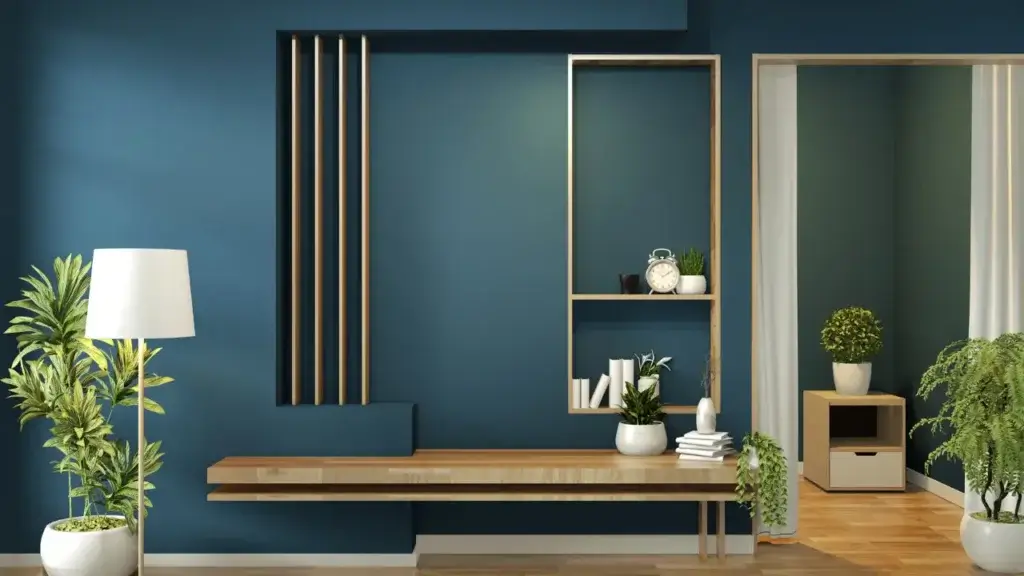
Technology is essential in modern living rooms, but it shouldn’t dominate your design. The goal? Make gadgets enhance your space—not detract from it. From hiding wires to choosing sleek devices, here’s how to blend tech seamlessly into your stylish, functional living room.
1. Hide Wires & Embrace Wireless
Tangled cables are the arch-nemesis of good design. Tame them with:
- Cable Management:
- Use adhesive cord clips, spiral wraps, or paintable cord covers along baseboards.
- Install a cable tray under desks or media consoles.
- Wireless Solutions:
- Opt for Bluetooth speakers, wireless charging stations, and smart TVs with minimal cords.
- Choose a TV mount with built-in cable channels (like MantelMount).
2. Choose Tech That Doubles as Decor
Select gadgets that complement your aesthetic:
- Samsung’s The Frame TV: Displays art when not in use.
- Sonos Speakers: Sleek designs in matte finishes (black, white, or wood veneer).
- Hidden Tech: Conceal routers or gaming consoles in stylish cabinets with ventilation.
3. Smart Home Integration
Automate your space without sacrificing style:
- Voice Control: Use Alexa or Google Nest to adjust lights, blinds, or thermostats hands-free.
- Smart Lighting: Philips Hue bulbs with dimmable, color-changing options for mood settings.
- Motorized Blinds: Control via app or voice, and choose fabrics that match your curtains.
4. Tech-Friendly Furniture
Furniture that accommodates modern needs:
- Media Consoles: Look for built-in outlets, USB ports, and ventilation (e.g., IKEA BESTÅ).
- Side Tables with Charging Stations: Built-in wireless pads or pop-up outlets.
- Sofas with Power: Sectionals featuring hidden USB ports or retractable charging docks.
Common Mistakes to Avoid
- Visible Tech Clutter: Keep gaming consoles, remotes, and cords out of sight.
- Overloading Outlets: Use surge protectors and avoid daisy-chaining power strips.
- Ignoring Scale: A massive TV can overwhelm a small room—opt for a size proportional to your seating distance.
Pro Tips for Effortless Tech
- Label Cables: Use color-coded tags for easy identification during setup or troubleshooting.
- Tech Audit: Declutter annually—retire outdated gadgets and donate unused ones.
- Multi-Functional Devices: Invest in a soundbar that enhances TV audio and streams music.
Conclusion
Designing a living room that’s both stylish and functional isn’t about perfection—it’s about intentionality. Over these 12 steps, you’ve learned how to craft a space that balances aesthetics with everyday life, from planning a layout that flows to weaving in tech that works invisibly. Remember, the magic lies in the details: a cohesive color palette sets the mood, smart storage tames chaos, and greenery breathes life into your sanctuary.
Whether you’re revamping a cozy apartment or refreshing a sprawling lounge, the key is to start small. Tackle one step at a time—maybe declutter with hidden storage (Step 7) or experiment with layered lighting (Step 5). Let your room evolve as you do, swapping decor or rearranging furniture to match your changing needs.
Your living room should tell your story. Display art that sparks joy, furniture that hugs you after a long day, and tech that simplifies, not complicates. Now it’s your turn: Roll up your sleeves, pick a step, and transform your space into a haven that’s as unique as you are.
FAQs
Q1: What’s the best color scheme for a small living room?
A: Stick to light, neutral tones like soft whites, warm beiges, or pale grays to make the space feel larger. Add pops of color through accessories like throw pillows or art. For more tips, revisit Step 3 on choosing a cohesive palette.
Q2: How do I choose lighting for a functional yet stylish living room?
A: Layer ambient, task, and accent lighting. Use dimmable overhead fixtures, floor lamps for reading, and wall sconces to highlight decor. Check Step 5 for detailed guidance on creating a balanced lighting plan.
Q3: Can I make a rental living room stylish without permanent changes?
A: Absolutely! Use removable wallpaper, large rugs, and freestanding furniture like bookshelves or room dividers. Swap out light fixtures with plug-in pendants and add personality with temporary decor. Step 10 has more small-space hacks.
Q4: How can I make my living room look expensive on a budget?
A: Focus on decluttering, invest in one statement piece (like a bold lamp or vintage mirror), and use metallic accents (gold frames, brass trays). Thrifted finds and DIY art can elevate the space affordably.
Q5: What’s the ideal rug size for my living room?
A: Ensure all furniture legs (or at least the front legs) sit on the rug. For example, an 8’x10’ rug suits most medium-sized rooms. Step 6 covers rug materials and sizing tips.
Q6: How do I mix modern and rustic design styles without clashing?
A: Pair clean-lined furniture (like a modern sofa) with rustic textures (wooden coffee tables, jute rugs). Use a cohesive color palette to unify the look. Step 4 shares tips on blending styles.
Q7: What are the best low-maintenance plants for a living room?
A: Snake plants, pothos, and ZZ plants thrive in low light and require minimal watering. For pet-friendly options, try spider plants or Boston ferns. Step 11 dives into styling with greenery.
Q8: How do I hide TV wires and tech clutter?
A: Use cable management kits, adhesive clips, or furniture with built-in cord storage (like media consoles with hidden compartments). Step 12 offers more tech-integration hacks.
Q9: Can I create a focal point in a plain room without a fireplace?
A: Yes! Use a large piece of art, a bold accent wall, or a stylish media console. Arrange furniture to frame the area. Step 8 breaks down focal-point strategies.
Q10: How often should I update my living room decor?
A: Refresh seasonally with throw pillows, blankets, or plants. Full redesigns every 3–5 years keep the space feeling current. Small, affordable swaps make a big impact!

My name is Mahi Uddin, and I’m a blog writer with over two years of experience specializing in creating engaging, informative content using AI tools. I contribute to InExDecor.com, where I share creative ideas and practical tips for transforming interior and exterior spaces into beautiful, functional environments. With a passion for storytelling and a knack for blending creativity with technology, I strive to craft blogs that not only inform but also inspire readers. When I’m not writing, you can find me exploring design trends or enjoying a good book with a cup of coffee.

